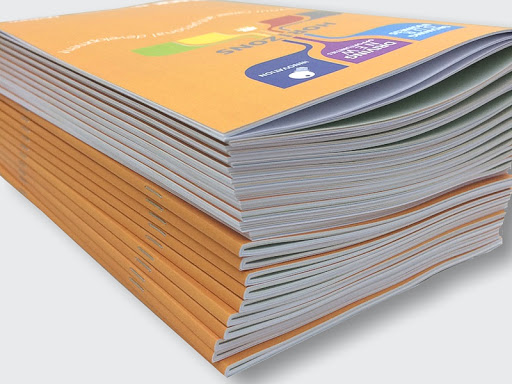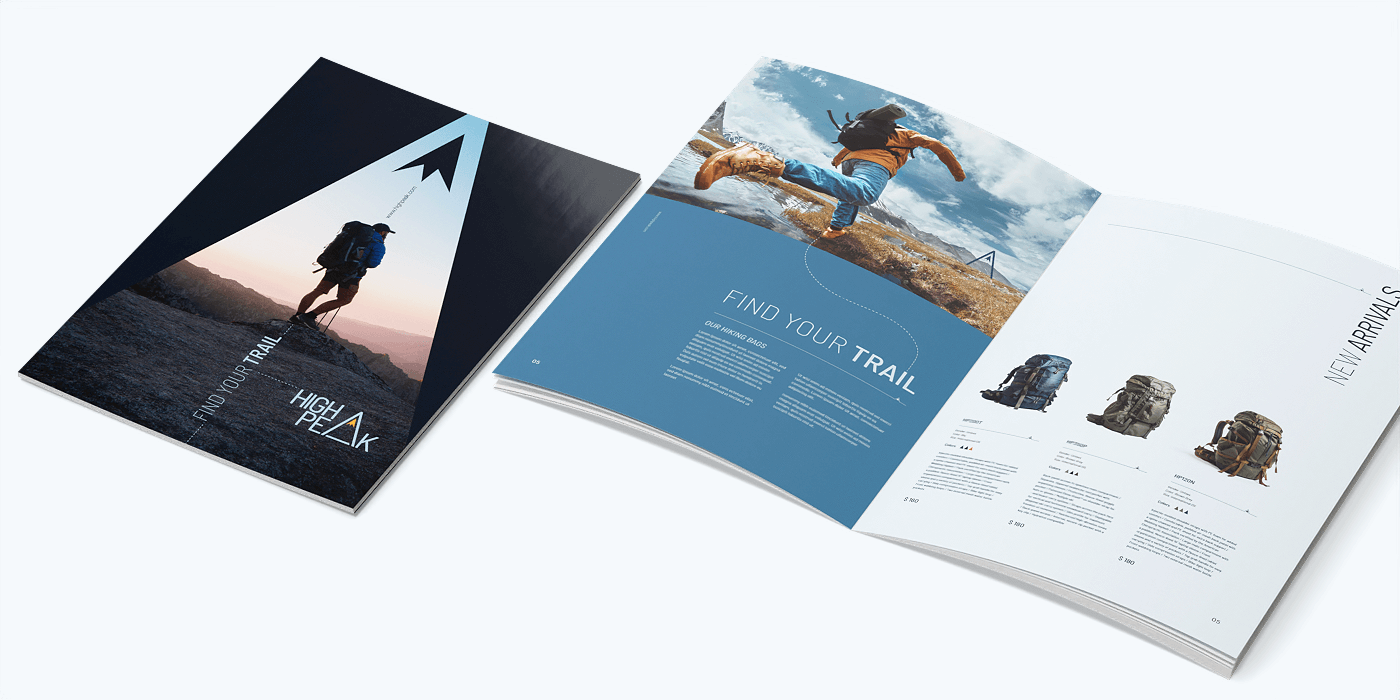What Makes Variable Content So Powerful in Booklet Printing?
What Makes Variable Content So Powerful in Booklet Printing?
Blog Article
The Crucial Guide to Understanding Brochure Printing Options and Techniques
The process of pamphlet printing entails multiple factors to consider that can greatly influence the last product. From selecting the suitable format and dimension to understanding the subtleties of binding approaches, each selection plays a crucial function. Furthermore, factors such as paper stock and printing methods further influence the efficiency of the pamphlet. As one browses these alternatives, it ends up being necessary to grasp exactly how they adjoin and what that means for the overall outcome.
Comprehending Brochure Styles and Sizes
When taking into consideration booklet printing, comprehending the numerous formats and dimensions readily available is essential for attaining the desired discussion. Brochures can be generated in countless styles, consisting of saddle-stitched, spiral-bound, and perfect-bound, each offering distinctive benefits. Usual sizes range from basic letter (8.5 x 11 inches) to smaller alternatives like A5 (5.8 x 8.3 inches), enabling for adaptability based upon web content and target audience.Selecting the appropriate dimension can influence both the format and reader involvement. Bigger dimensions could fit aesthetically driven content, while smaller layouts might be more mobile and straightforward. In addition, the number of pages influences the choice of binding method, as thicker pamphlets may call for stronger bindings. Eventually, comprehending these facets enables an extra customized technique, making sure that the last item aligns with the desired message and visual, enhancing the total performance of the interaction.
Selecting the Right Paper Stock

Binding Techniques: Factors To Consider and alternatives
When it pertains to binding approaches for booklets, numerous alternatives are readily available, each with distinctive advantages. Saddle stitch binding provides a cost-effective remedy for thinner brochures, while ideal binding techniques provide an even more refined try to find thicker publications. Wire-O binding stands out for its durability and convenience of use, making it excellent for records that require adaptability.
Saddle Stitch Binding
Saddle stitch binding provides a sensible and economical solution for constructing brochures, making it a preferred option amongst publishers and services. This binding technique entails folding sheets of paper in half and stapling them along the fold line, producing a neat and orderly look. Commonly ideal for pamphlets with a lower page matter, saddle sewing is suitable for magazines, sales brochures, and instructional materials. The simplicity of this technique permits quick production and is usually favored for advertising things or brief runs. However, it is important to keep in mind that saddle stitch binding might not be ideal for thicker pamphlets, as the back might not hold up under increased weight. Generally, it continues to be a trustworthy alternative for numerous printing projects.
Perfect Binding Techniques
Perfect binding is a widely made use of technique that offers a refined and expert surface to publications and pamphlets. This technique entails gluing the web pages with each other at the spine making use of a solid adhesive, enabling a clean edge and the ability to hold a larger number of pages compared to saddle sewing. Perfect binding is particularly ideal for thicker pamphlets, such as catalogs and yearly records, where a sturdy, level spinal column is desired. Additionally, it supplies the alternative for a printed cover that can be designed to improve visual allure. Nevertheless, factors to consider such as web page matter, paper weight, and the planned use the pamphlet should be taken into consideration, as they can impact longevity and total quality.
Wire-O Binding Alternatives
Wire-O binding, recognized for its sturdiness and versatility, uses an exceptional alternative for pamphlets that require easy page turning and a specialist appearance. This binding approach utilizes a series of metal loopholes that hold pages securely, enabling them to lie flat when open. It is especially appropriate for directories, guidebooks, and discussions as a result of its durable nature. Wire-O binding is offered in numerous colors and sizes, accommodating different web page matters and densities. Furthermore, it allows the incorporation of covers and tabs, improving the booklet's overall visual. Factors to consider for Wire-O binding include the selection of wire color, the size of the loopholes, and the level of customization desired, every one of which can profoundly affect the end product's appearance and functionality.
Digital vs. Offset Printing: Which Is Best for You?
When choosing a printing technique for booklets, understanding the differences between digital and balance out printing is necessary. Digital printing utilizes modern-day innovation to produce top notch prints rapidly and affordably, making it ideal for brief runs or tasks calling for fast turnaround times. It enables for personalization, giving the ability to publish on-demand with minimal waste.In comparison, counter printing is a conventional approach that masters producing huge amounts with consistent quality. It entails transferring ink from a plate to a rubber covering, after that to the paper, which leads to lively shades and specific details. However, balance out printing usually requires longer arrangement times and is much more affordable for larger volumes.Ultimately, the selection between electronic and balance out printing depends on project requirements, budget, and wanted quantity. For small, time-sensitive projects, digital may be the most Full Article effective selection, while countered may be more suitable for larger, premium manufacturings.

Designing Your Booklet: Tips and Best Practices
When making a pamphlet, cautious interest to layout, font option, and shade use can greatly enhance its performance. A well-structured design guides the reader's eye, while suitable font basics styles guarantee readability and share the preferred tone. Additionally, reliable usage of color can stimulate emotions and highlight crucial info, making the overall design extra impactful.
Selecting the Right Layout
Just how can one efficiently choose the ideal layout for a pamphlet? It is important to review the booklet's objective and target audience. A clean, arranged layout improves readability and engagement. Making use of a grid system can aid in lining up aspects constantly, producing a professional appearance. In addition, including visual power structure with differing sizes and placements of pictures and message can direct the reader's eye and stress crucial details. It is also essential to leave sufficient white area, which protects against overcrowding and enables for far better focus. Examining different layouts with mock-ups can supply understanding right into how the design carries out in real-world situations, making sure that the last item fulfills both functional and aesthetic requirements.
Selecting Suitable Font Styles
A well-chosen font style can considerably improve the general style of a brochure, matching the design and strengthening the material's message. The choice of font styles ought to think about readability, particularly for body text, as it guarantees the information comes to all readers. Sans-serif fonts are often preferred for electronic layouts, while serif typefaces can provide a traditional feel in printed materials. It's recommended to restrict font selections to 2 or three to preserve visual coherence. Additionally, font style size plays an important role; headings need to be distinctive however not overwhelming, while body text should be comfy for reading. When selecting typefaces, positioning with the booklet's motif and target market is vital for effective interaction and visual appeal.
Reliable Use of Color
Color works as a powerful device in brochure layout, leading and shaping assumptions reader feelings. It can stimulate feelings of exhilaration, count on, or peace, depending upon the tones selected. Designers need to consider color concept concepts, making certain that the chosen scheme straightens with the pamphlet's message and target market. As an example, making use of cozy shades like red and orange can develop urgency, while cooler tones like green and blue foster tranquility.Additionally, contrast plays a crucial role; corresponding colors can boost readability and visual charm. Uniformity in color usage throughout web pages better strengthens brand identification and cohesion. Inevitably, reliable shade execution not only captures interest but likewise enhances the pamphlet's objective, making it a necessary aspect of effective design.
Completing Touches: Coatings and Special Results
While many take into consideration the material and layout of a booklet the most important elements, the completing touches, such as coatings and special effects, play an essential role in boosting its general appeal. Coatings can give security and resilience, guaranteeing that the brochure endures deterioration. Matte coatings supply an innovative, non-reflective surface, while glossy finishings can make colors appear more captivating and lively. Special effects, like embossing or aluminum foil stamping, include a tactile measurement that can develop a remarkable perception. These methods can highlight specific areas, accentuating vital information or creating visual interest. In addition, UV finish can offer a high-shine coating that raises the total look.Together, these ending up touches not just boost the pamphlet's visual however additionally interact professionalism and reliability and attention to information, eventually leaving a long lasting influence on the viewers.
Expense Considerations for Booklet Printing
Understanding the different expense factors to consider for pamphlet printing is crucial for companies and services intending to enhance their budgets. Secret variables affecting costs consist of the option of ink, paper, and binding methods. Better materials, such as premium paper or specialized inks, typically boost the overall expenditure. In addition, the dimension and web page matter of the booklet play a significant duty; larger booklets require more resources and time to produce.Another vital factor to consider is the printing technique, whether electronic or countered, as each has its very own prices structure and suitability for different quantities. Services should likewise consider style costs, which can vary based upon complexity and using professional services. Ultimately, delivery and handling costs can contribute to the total, specifically for large orders. By reviewing these components, organizations can make enlightened decisions that line up with their monetary abilities while attaining the desired high quality in their published products.
Often Asked Concerns
What Are the Ecological Effects of Pamphlet Printing?
The environmental influences of booklet printing include logging from paper production, carbon discharges from transportation, and waste generation from disposed of materials - Booklet Printing. Sustainable practices, such as making use of recycled paper and green inks, can minimize these impacts
How Can I Make Sure Color Precision in My Brochure?
To ensure color precision in a brochure, one ought to make use of adjusted monitors, use professional shade profiles, carry out test prints, and choose high-quality printing services that provide color matching and proofing choices for ideal outcomes.
What Is the Regular Turnaround Time for Brochure Printing?
The regular turnaround time for booklet printing differs relying on the complexity and amount - Booklet Printing. Usually, it varies from a few days to two weeks, affected by variables such as publishing techniques and ending up needs
Are There Minimum Order Quantities for Booklet Printing?

Can I Print Pamphlets in Several Languages?
Publishing pamphlets in numerous languages is feasible. Numerous printing solutions provide choices for multilingual or bilingual formats, enabling efficient interaction. discover here Cautious preparation assurances that design elements fit different languages without endangering readability or appearances. Furthermore, variables such as paper supply and printing strategies more influence the efficiency of the brochure. When taking into consideration brochure printing, understanding the different layouts and sizes available is necessary for achieving the desired discussion. When picking a printing approach for brochures, recognizing the differences in between electronic and balance out printing is crucial. In addition, the size and web page count of the brochure play a significant function; bigger booklets require more resources and time to produce.Another important factor to consider is the printing strategy, whether digital or balanced out, as each has its very own prices structure and suitability for various amounts. The ecological effects of booklet printing consist of logging from paper production, carbon exhausts from transport, and waste generation from thrown out products.
Report this page